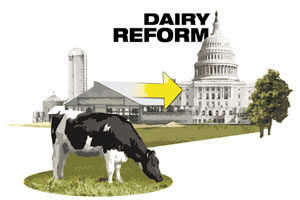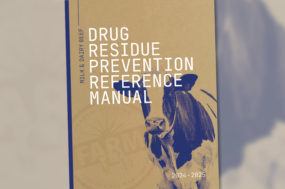Recently, the National Milk Producers Federation (NMPF) held its annual meeting in Reno, Nev. The key message from NMPF was the importance of unity amongst the industry as we go into the next Congress with hopes of making significant reforms to dairy policy. Its proposed reforms, known as the “Foundation for the Future” (www.futurefordairy.com) is a collection of proposals aimed at reforming several different government policies surrounding our industry. Many are well aware of the efforts of myself, MPC and other groups around the country in promoting the Costa-Sanders Bill (a.k.a. the “Dairy Price Stabilization Act,” or H.R. 5288/S. 3531). These bills are the results of several years of work in crafting an effective production management program that will allow our industry to continue growing to meet new demand, while at the same time sending real-time signals to dairy farmers to better manage future milk production growth.
MPC continues to advocate for this legislation, as it is still the only dairy reform bill that has been introduced in Congress and has garnered support from congressmen and senators from coast to coast.
With that said, at the end of the day the only chance we have for successfully making positive change for our industry is if the producer side of the industry is unified behind a single legislative proposal. We’ve documented the predictable, yet disappointing opposition by the nation’s processors (International Dairy Foods Association) towards any effort to implement a production management strategy as part of our solution. Given this inevitable opposition, the producer sector, which has been engaged in a healthy debate for the past couple years over the direction of our industry, doesn’t have the luxury of bickering once it is ready to go to Congress with a proposal for reform. And we are rapidly approaching that point; hence, the need for unity in the ranks.
To that end, NMPF needs to develop the legislative language necessary to implement the Foundation for the Future (which sources have indicated is already happening). That language will include the details of the proposal, many of which are already available on its website. When those details are in place, every dairy association, cooperative and other interested producer across the country will need to make a decision about whether or not the policy proposal improves our position from the status quo.
As I mentioned, the past two years has been a time of great debate amongst producers. Many issues have been raised, and numerous proposed solutions have been discussed. While I certainly cannot address each and every one of these issues, a few major points come to mind:
• The need to address the boom/bust volatility in our milk price.
• The unfairness and inadequacy of the current safety net programs (MILC and price support program).
• The need to take a dairyman’s cost of production into account when establishing future dairy policy.
Let’s look at each of these issues, and how NMPF has addressed them in the Foundation for the Future.
The need to address the boom/bust volatility in our milk price
This is perhaps the biggest driving force behind the development of current dairy policy proposals. The economic devastation for dairy farmers in 2009 and 2010 has highlighted the inadequacy of our current regulatory structure. It is clear to virtually every producer that we currently lack the tools necessary to maintain better balance between milk production and dairy product consumption, which has resulted in chronic imbalances in supply and demand, and extended periods (to say the least) of devastating losses as the market tells our industry to cut back milk production to meet demand.
NMPF’s Foundation for the Future has vastly improved in this area over the past year. In early drafts of the proposal, the CWT program was heralded as an adequate tool for better balancing our industry. Since then, NMPF has wisely adopted pieces of other proposals (such as the Costa/Sanders Bill and a “Marginal Milk Pricing” proposal made by Agri-Mark Cooperative in the Northeast) to create the “Dairy Market Stabilization Program,” an essential piece of Foundation for the Future. Under this program, during periods of diminishing margins for dairy producers, a direct and strong signal will be sent to dairy farmers to cut back short-term milk production in an effort to better align national production with demand. For those dairies that choose not to cut back milk production, they will contribute to a fund established to spur demand for dairy products, helping the supply/demand balance on the other side of the ledger. While those of us who have been working on this issue for several years may have alternative ideas on how exactly such a program is structured, there is no doubt that a program structured this way is a vastly superior option to what we have now. If you don’t believe that just based on reading the policy, you can also check out economic analysis demonstrating how this program compares to the status quo ( http://dairy.wisc.edu ).
The unfairness and inadequacy of the current safety net programs (MILC and price support program)
This issue has been raised in all forums, whether amongst the industry, in Congressional hearings, or anywhere else dairy policy has been discussed. It has become painfully clear that a price support program that “supports” an on-farm price of $9.90 per hundredweight (and that’s if the program actually bought cheese, which it hasn’t done in years) is not a sufficient “support program.” Further, it has become clear that the structure of the support price program, in buying only specific commodity-grade products, has sent an inappropriate signal to develop processing capacity for these products that can be sold to the government, even if other similar products enjoy stronger market demand. And lastly, it has been pointed out by those who engage in the world markets that a price support program for exportable dairy products has resulted in the U.S. “supporting” the global market as well, a heavy burden to carry.
On the issue of the Milk Income Loss Contract (MILC) program, it is no secret that the structure of the program greatly disadvantages “larger” producers (with a 2.985 million pound cap on payments, a “larger” producer can be a 200-cow dairy). And while the 2008 Farm Bill added a feed cost adjuster to the program, it is still woefully inadequate for protecting the margins of our nation’s dairy farmers.
NMPF’s Foundation for the Future has recognized these realities and has taken a bold step – eliminating these programs and putting in its place a bold “Margin Protection Program” that aims to provide dairy farmers with a more adequate safety net than either of these two programs are capable of providing (more on the Margin Protection Program in the next section).
The need to take a dairyman’s cost of production into account when establishing future dairy policy
This has been a rallying cry of many dairymen throughout the past two years of devastating negative margins on the farm. It’s an immensely important point – after all, if our dairies can’t operate profitably, who will be around to supply the U.S. and the world with nutritious dairy products?
NMPF’s Foundation for the Future has outlined the “Margin Protection Program” as a way of better protecting dairy farmers’ equity. The program utilizes a national “milk-feed margin” (or in other words, the difference between the all-milk price and the average cost of feeding your cows) to drive a direct subsidy program for dairy farmers. Foundation for the Future relies on the Dairy Market Stabilization Program to help keep supply and demand in closer balance (which is the key to maintaining a market that will pay a profitable price to dairy farmers), but in periods of imbalance, whether that’s due to a falling milk price or an escalation in feed costs (sound familiar?), this program would provide a safety net payment to dairy farms, giving our dairies better protection against catastrophic attacks on farmer equity.
Further, the Margin Protection Program is customizable for each dairy farmer, with a “base” level of protection available for free, and additional protection available at a subsidized premium. For instance, under this program, in addition to the $4 per hundredweight margin protection available in the “base” plan, a dairyman could purchase an additional $2 per hundredweight in “supplemental coverage” (for a total of $6 per hundredweight coverage) for about $0.15 per hundredweight in premiums (about what you pay for advertising). While some will say that this is well short of a government guarantee that producers’ “cost of production” is constantly protected, it is undeniable that the Margin Protection Program is a new and interesting concept that would protect farmers from catastrophic economic conditions, while at the same time keeping the government from interfering with domestic and international sales of dairy products. What I mean by that is, under this program, if the market fundamentals call for milk to be sold for devastatingly low prices, those sales can still be made, and those markets can still be maintained, while having the equity in our nation’s dairy farms largely protected.
In conclusion, we can all find reasons to disagree and debate various aspects of all the proposals out there, including NMPF’s Foundation for the Future. But the reality we face, as the producer sector, is that we cannot afford to miss this opportunity for fundamental change in the dairy industry. We must make every effort to rally dairy producers behind a common proposal, and with NMPF’s broad reach and political influence, I’m hard-pressed to find a better starting point than their proposal. It’s come a long way since this whole debate began, and we still need to see the final details in legislative language (as well as the reforms to Federal Milk Marketing Orders, which are reportedly still in flux). But I strongly urge each of you to take time out of your day to explore the program as it’s been presented. Spend some time on www.futurefordairy.com . Come up with a list of questions, and send them to NMPF. The new Congress will be sworn in next January, and we need to make the best effort possible to come to Congress with producers across the country united behind a single proposal. There are innumerable other issues that we will need to work on in years to come, but let’s see what kind of progress we can make on these immediate issues now. PD
—Excerpts from Milk Producers Council weekly newsletter, Oct. 29, 2010.

-
Rob Vandenheuvel
- Milk Producers Council
- Email Rob Vandenheuvel



